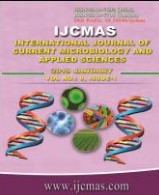


 National Academy of Agricultural Sciences (NAAS)
National Academy of Agricultural Sciences (NAAS)

|
PRINT ISSN : 2319-7692
Online ISSN : 2319-7706 Issues : 12 per year Publisher : Excellent Publishers Email : editorijcmas@gmail.com / submit@ijcmas.com Editor-in-chief: Dr.M.Prakash Index Copernicus ICV 2018: 95.39 NAAS RATING 2020: 5.38 |
Stem rot of rice (Oryza sativae L.) caused by Sclerotium oryzae Catt. is found to occur frequently in Manipur infecting all cultivated lowland rice cultivars and become a major concern in rice production. Local strains of Pseudomanas fluorescens and Trichoderma collected from rice fields of Imphal East and Imphal West districts of Manipur were screened for their ability to control S. oryzae and production of different biocontrol mechanisms under laboratory conditions. Further, combined application of talc formulations of selected strains of P. fluorescens IE 62 and T. inhamatum (T 80) (based on in vitro antifungal activity, production of cell wall degrading enzymes and secondary metabolites) were assessed for their plant growth promotion and biocontrol ability under greenhouse and field conditions. Seed germination, root length, shoot length and plant height were enhanced by treatment with P. fluorescens IE 62 and T. inhamatum T 80 in vitro conditions as compared to single applications under greenhouse and field conditions. Field data revealed significant reduction in stem rot incidence, lesion number and size when applied in consortia. Percent reduction in lesion number and size were recorded as 35.15% & 26.14% when applied with P. fluorescens IE 62 alone and 51.63% & 14.43% with combined applications as compared to control plot indicating better biocontrol activity. The results indicated the effectiveness of combined application of local strains of P. fluorescens IE 62 and T. inhamatum T 80 resulting increased plant growth and control of S. oryzae and therefore can be used as potential bioagents for managing Stem rot disease in rice.
 |
 |
 |
 |
 |